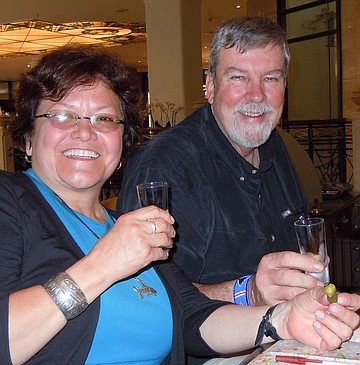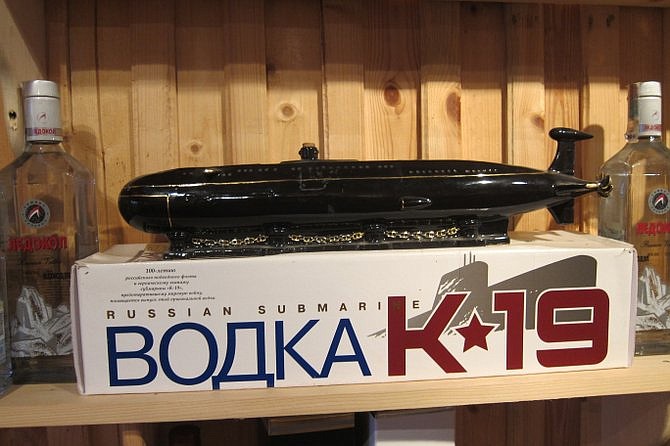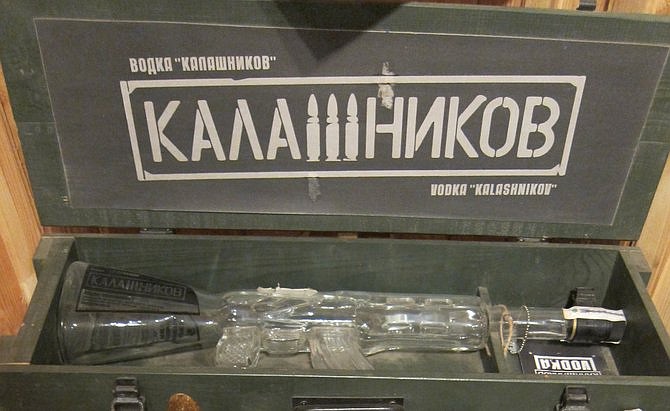 Facebook
Facebook
 X
X
 Instagram
Instagram
 TikTok
TikTok
 Youtube
Youtube

The bar at Moscow’s Marriott Grand Hotel on Tverskaya Street – a hop, goose step and jump up the road from the Kremlin – is the place to learn the fine art of drinking vodka, Russian-style.
Bartender Mikhail Gerchenko corralled my wife I as soon as we had checked in by asking if I knew how to drink vodka. When I answered affirmatively, he said, “No you don’t,” and waved us over to his bar.
He proceeded to pour drinks, starting with what he called “people’s” vodka, then working up in class through names un-pronounceable to me, all the while pouring with grand gestures, and lecturing on the finer points of how filtering through charcoal, silver or gold gives this national drink an ever-increasing buttery taste.

He insisted vodka must be drunk from an iced shot glass that was run under warm water and then kept in the freezer for exactly 15 minutes. Each shot must be preceded by a very salty bite of gherkin (left). He used this time to relate how his father and grandfather had tended bar, a profession that carries great cache in Russia, and that his great-grandfather had been a valet and chief vodka server to Nicholas the Second, last ruling Czar until his untimely demise.
By this time we were under his storytelling spell, even if it was obvious he was spinning a slightly taller yarn than the facts supported.
According to Mikhail, his ancestors were the only ones to ever pour a drink for the imperial Russian aristocracy and that same grandfather also helped to found the Vodka Museum in the fairytale village of Mandrogi, a tiny speck on the Volga destroyed during Second World War battles and rebuilt as something between a movie set and a Gaudí nightmare.

There, in a tiny log cabin at the edge of a wood, you can peruse over 3,000 different types of vodka – all in their own unique containers, such as a porcelain reproduction of the submarine Kursk that went down a few years ago with all hands (left), while staring at photos of Russian leaders from Nikita Khrushchev to Vladimir Putin, all bending their elbows at their venerable bar, proving that in Russia, vodka is a way of life long after death.

By the end of his story, we had lost track of our shots and our Western palettes were not sophisticated enough to appreciate the subtle differences between the vodkas we sampled, but we left with Anglo-Russian relations on a high and a big hit to our credit card.
On our way out we noticed a wooden ammo case holding a glass bottle of Kalashnikov Vodka in the shape of an AK-47 by the manufacturer of the same name.
"It’s what we really call a 'shot' of vodka," yelled Mikhail with a bow and flourish.


The bar at Moscow’s Marriott Grand Hotel on Tverskaya Street – a hop, goose step and jump up the road from the Kremlin – is the place to learn the fine art of drinking vodka, Russian-style.
Bartender Mikhail Gerchenko corralled my wife I as soon as we had checked in by asking if I knew how to drink vodka. When I answered affirmatively, he said, “No you don’t,” and waved us over to his bar.
He proceeded to pour drinks, starting with what he called “people’s” vodka, then working up in class through names un-pronounceable to me, all the while pouring with grand gestures, and lecturing on the finer points of how filtering through charcoal, silver or gold gives this national drink an ever-increasing buttery taste.

He insisted vodka must be drunk from an iced shot glass that was run under warm water and then kept in the freezer for exactly 15 minutes. Each shot must be preceded by a very salty bite of gherkin (left). He used this time to relate how his father and grandfather had tended bar, a profession that carries great cache in Russia, and that his great-grandfather had been a valet and chief vodka server to Nicholas the Second, last ruling Czar until his untimely demise.
By this time we were under his storytelling spell, even if it was obvious he was spinning a slightly taller yarn than the facts supported.
According to Mikhail, his ancestors were the only ones to ever pour a drink for the imperial Russian aristocracy and that same grandfather also helped to found the Vodka Museum in the fairytale village of Mandrogi, a tiny speck on the Volga destroyed during Second World War battles and rebuilt as something between a movie set and a Gaudí nightmare.

There, in a tiny log cabin at the edge of a wood, you can peruse over 3,000 different types of vodka – all in their own unique containers, such as a porcelain reproduction of the submarine Kursk that went down a few years ago with all hands (left), while staring at photos of Russian leaders from Nikita Khrushchev to Vladimir Putin, all bending their elbows at their venerable bar, proving that in Russia, vodka is a way of life long after death.

By the end of his story, we had lost track of our shots and our Western palettes were not sophisticated enough to appreciate the subtle differences between the vodkas we sampled, but we left with Anglo-Russian relations on a high and a big hit to our credit card.
On our way out we noticed a wooden ammo case holding a glass bottle of Kalashnikov Vodka in the shape of an AK-47 by the manufacturer of the same name.
"It’s what we really call a 'shot' of vodka," yelled Mikhail with a bow and flourish.
Comments